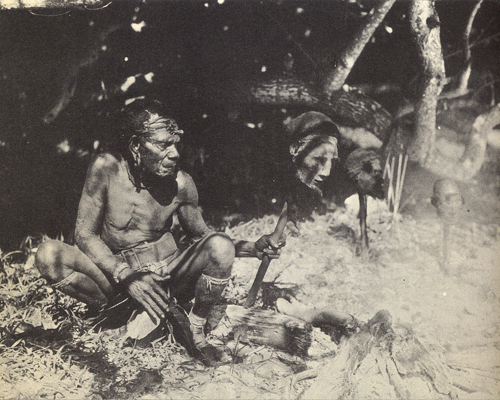“Late in the afternoon, Martin and I walked a little way from the village talking over the best method of taking leave of our strange host. We strayed farther than we realized, and came upon a much traveled path leading to the tiny doorway of an unusually large hut. Always curious, Martin got down on his hands and knees, peered in and entered. I followed. As my eyes gradually became adjusted to the dim light I saw what looked like baskets of black grapefruit. I picked one up to examine it more closely and dropped it in horror.
“It was a dried human head!
“There were dozens piled in baskets. More grinned at us from the eaves in a macabre frieze. Pendants of skulls dangled from the rafters. Untidy heaps of human bones lay in the corners. I loosed a shuddery groan. Martin clapped his hand over my mouth and dragged me as quickly as possible through the doorway into the open, and here, after one quick look about, he took my arm and hurried me back to the path leading to the village. Martin always regretted not being able to get a picture of the head-house.”
—From I Married Adventure by Osa Johnson, 1940
The most important building in any village in Vanuatu is the nakamal, a sort of men’s clubhouse. Sometimes it’s just the place where the men meet at the end of the day to talk and drink kava (sort of a South Seas sports bar), but for ni-Vanuatu who truly follow their cultural heritage, as they do in Vil-Vil, it’s also part school and part church.
After the men of the village had done a few songs and dances for us, I sat down with Chief Bule Kone and we traded off asking each other questions. I asked him how often he visited Luganville, the largest town on Espiritu Santo and a good three hour drive away.
“Maybe two time…maybe three, “ he said.
“A month?”
“A year.”
Then he asked me what church I belonged to. I told him that, sadly, I didn’t go to church.
“Never?”
I smiled. “Maybe two time…maybe three.”
“A year?” he asked me.
“In my life.”
He laughed at that.
What I was really curious about was how they educated the children in the village. Obviously there was no bus coming by bright and early in the morning to pick the kids up who lived in the jungle.
“I will explain it to you,” he said, leading me to a long, low-slung building with a low, narrow door and thatched roof—the nakamal. Inside, I had to stand motionless for a moment to let my eyes adjust to the darkness. There were a couple of rudimentary louvered windows on one end of the house but they were closed to keep out the tropical sun. Other than that, the only light came from what spilled in through the doorway.
Against the walls were a series of low bunks, made from bamboo poles, topped with thin bedding. The top bunks were covered in green mosquito netting which could be lowered to cover the bottom bunk as well. In a corner some bricks had been stacked in a square and in the middle, a small fire was smoking and smoldering. Scattered about the dirt floor were some tin pots and pans, sandals, and a plastic tub for washing.
This is how we teach our children, Bule Kone said, spreading his arms about. When the boys—and only the boys—are 14 or 15, they must come here to live and take care of themselves, cook their own food. And in the afternoon, the elders come in and make up a batch of kava and everyone sits around talking about god and learning all the rituals that are still practiced and that keep the village together. While Bule Kone was explaining this to me, one of the young men was shredding a kava root the size of a stock of corn into a hollowed-out log.

Villager shreds kava from a root like the one Chief Bule Kone, right, holds. Photo by David Lansing.
“This,” Bule Kone said, holding a root in his hand, “is our pen. And this,” he said, picking up a handful of shredded kava, “is our paper.”
The shredded root was mixed with water and filtered through coconut fibres, then poured into a coconut shell bowl which was handed to the chief. He drank it silently in a single gulp. Then a second bowl was prepared and handed to me. I did likewise, the muddy liquid tasting pungent and peppery. Everyone else followed. And then I had a second round, my feeling being you can never get too much education.


Recent Comments